Transcendental Meditation Definition and its Benefits
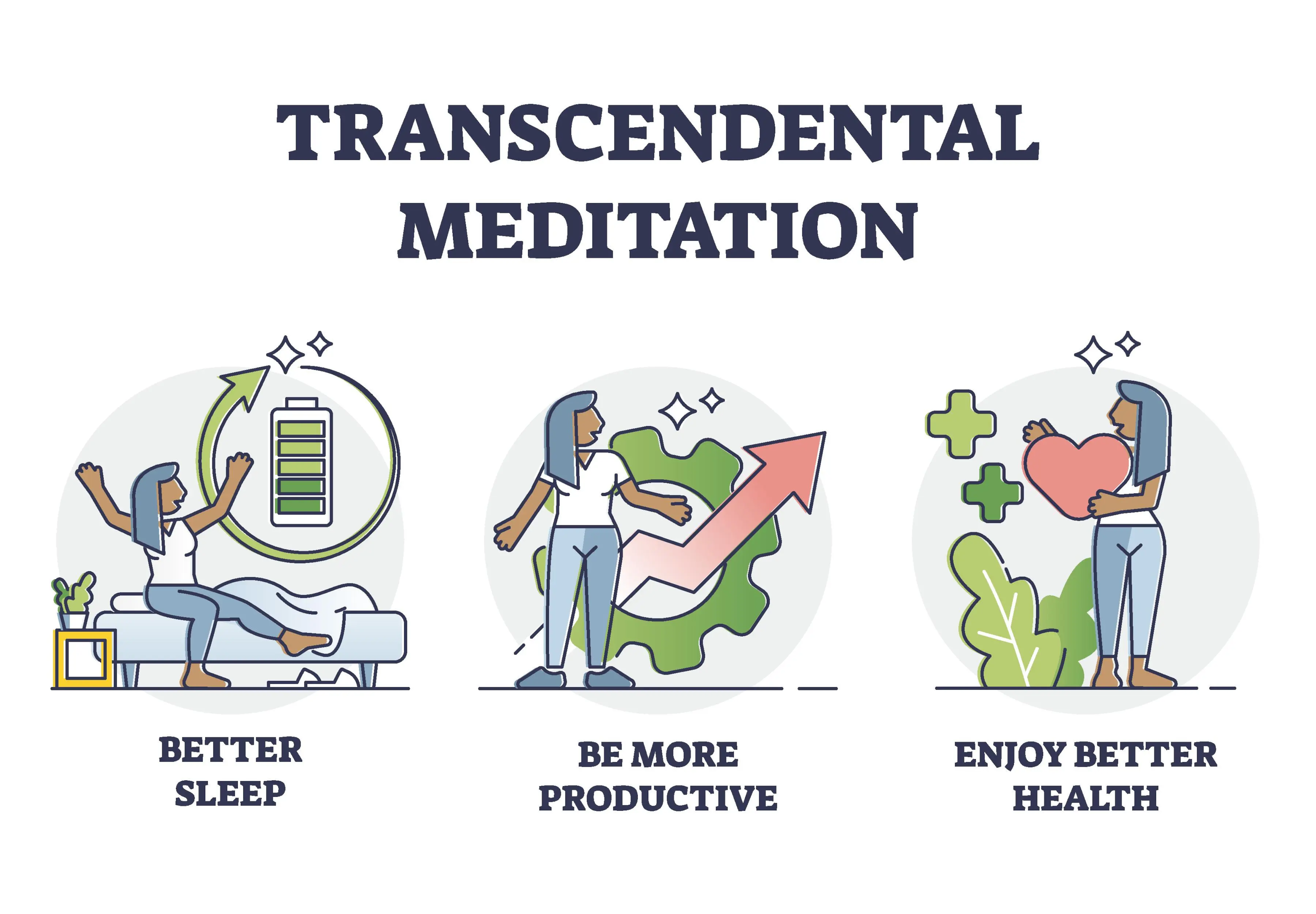
Transcendental meditation, or TM, involves mentally repeating a mantra while being completely silent. Transcendental meditation focuses on bringing your body into a relaxed state of attentiveness. You are fully alert despite your totally relaxed body and calm mind. Your busy mind becomes still during this sort of meditation, allowing you to transcend into a state of pure consciousness.
In the middle of the 1950s, Maharishi Mahesh Yogi invented the technique in India. TM proponents assert that the practice has physiological advantages like lowering the risk of heart disease and high blood pressure as well as psychological advantages like stress alleviation and access to higher levels of consciousness.
TM is centered on concentrating on a single mantra that is silently repeated, as opposed to mindfulness-based meditations that emphasize emptying the mind of thoughts and gently returning the attention to the present moment when you recognize that your mind has wandered (as it will). Each person's mantra can vary, and individuals who successfully finish training programs are typically given mantras based on their individual traits and are expected to be a good fit.
The benefits of Transcendental meditation
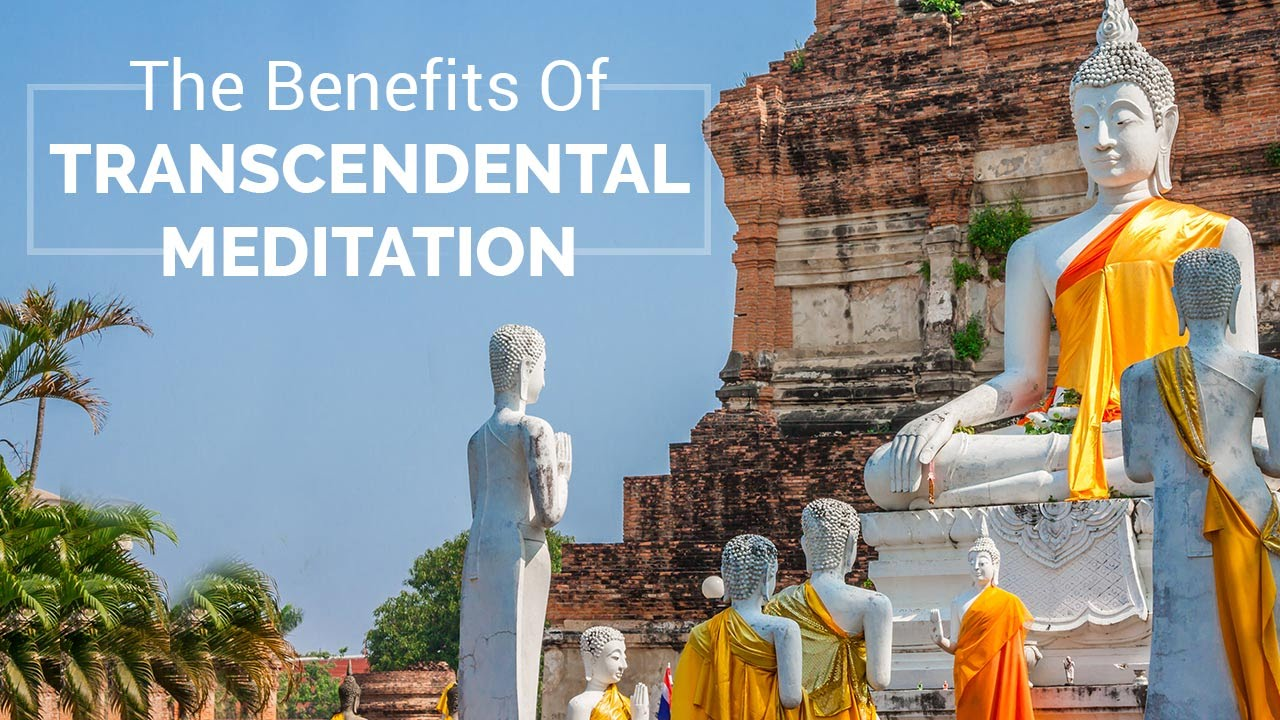
Transcendental meditation benefits include:
Physical benefits
Reduced blood pressure: Transcendental meditation has been demonstrated to lower blood pressure. Transcendental meditation has been found in studies to be as effective as blood pressure medicine in lowering blood pressure.
Sleep enhancement
Pain relief and/or diversion from pain
Mental health benefits
Stress, anxiety, and sadness are reduced.
Post-traumatic stress disorder treatment.
Self-esteem enhancement.
Cognitive benefits
Productivity, performance, and problem-solving abilities have all improved.
Improvements in creativity, intelligence, and alertness.
Improved energy, concentration, and memory.
Improved mental and emotional clarity.
Compassion and gratitude have grown.
Inner serenity and improved quality of life
Scientists have recently focused on the potential of transcendental meditation to decrease blood pressure and protect against heart disease.
A meta-analysis of nine randomized controlled trials published in 2008 discovered that frequent practice of TM may have the capacity to reduce systolic and diastolic blood pressure to clinically relevant levels.
Another meta-analysis published in 2017 revealed that practicing transcendental meditation could lower systolic and diastolic blood pressure at the same rate as other lifestyle improvements including diet and exercise. However, the study's authors also recommended for more independent research.
A 2019 randomized control trial of 85 Black people with hypertension found that TM may help prevent cardiovascular disease in high-risk patients.
Transcendental Meditation was introduced to the world by Maharishi Mahesh Yogi.
In 1957, Maharishi Mahesh Yogi established an international organization to propagate the knowledge of Transcendental Meditation throughout the world. He initially visited the United Kingdom in 1959.
Maharishi Mahesh Yogi: The mind, in its active state, learns through teaching to experience its own less active states, its gradually reduced active states, until it eventually cognizes the transcendental state of consciousness. But, in order to do so, we must keep in mind that the mind has usually been permitted to wander around in the realms of knowledge, power, or the pursuit of happiness for so long that it must be taught how to recognize itself again. That is why education is required. After practicing TM, one is aware of one's natural condition. However, in order to realize this, one must be liberated from unnatural routines, acts, and experiences. Most people have never encountered Transcendental Consciousness, pure consciousness, or the true essence of the mind.
Transcendental Meditation is Mantra Meditation

The key difference between TM and other kinds of meditation is the mantra you're instructed to repeat during a meditation session. The mantra in TM is a meaningless sound that is utilized as a vehicle to assist the mind settle down. During the meditation practice, other types of meditation use words, phrases, or visualizations. You want to achieve absolute stillness and consciousness by focusing solely on your mantra.
While some meditation practices urge emptying the mind of all thoughts, TM invites thoughts to come and go, much like watching a cloud float by.
How to Do Transcendental Meditation
To study TM, you must first be taught by a registered Maharishi Foundation teacher. A one-hour lecture and one hour of formal one-on-one training with your teacher are included in the TM course. Your teacher carefully tailors the course to your needs.
You will receive your mantra after these sessions. Your mantra is chosen for you by your TM teacher. Following that, you will have three follow-up appointments. During these sessions, you will meditate under the supervision of your tutor. Then, on your own, you can begin to practice TM every day, twice a day.
What You can expect from Transcendental meditation
Much more than relaxation
Meditation is becoming increasingly popular for stress management, yet the genuine experience of transcending has far more significant effects than simply relaxing. Unfortunately, until recently, the world had been unaware of how to readily transcend. Transcending is described in ancient texts from the world's oldest heritage of knowledge as the highest human experience that is required for our full human growth. We can now validate this with modern science by monitoring what happens in the body, particularly the brain, during TM practice.
Deep Rest
The mind enters a condition of full interior silence when it exceeds the finest impulse of thought. This occurs in an entirely natural and seamless manner. We can't and shouldn't strive to silence the mind. The mind will travel there on its own with the correct method.
The mind and body are inseparable, and when one goes, the other must follow. The body will enter a profound level of physical relaxation while in this deep state of mental rest. This form of rest has been shown to be substantially deeper than conventional relaxation or eyes-closed rest and is frequently even deeper than sleep rest.
This deep relaxation is plainly quantifiable. This graph depicts the average impact size results of at least 30 research conducted around the world during a 15-year period. It demonstrates that during TM practice, the respiratory rate, a measure of relaxation, decreases significantly more than during eyes-closed rest. Other relaxation markers, such as basal skin conductance and the stress hormone plasma lactate, exhibit similar declines, indicating a far deeper rest than typical relaxation.
This deep rest activates our bodies' innate healing potential. Tensions are relieved by relaxation. The body has a fully natural way of releasing accumulated tensions. This is what happens while we sleep, although sleep does not always go deep enough to erase more deeply seated, traumatic pressures. Transcending provides a level of rest that can aid in the resolution of deeper-seated concerns.
Sometimes the outcomes are more dramatic with people who need it the most. A recent study of US Iraq War veterans found that merely 8 weeks of TM practice resulted in a 50% reduction in PTSD and depression. The findings were so spectacular that CNN TV covered it on Veteran's Day in the United States.
This confirmed previous research with Vietnam war veterans conducted 25 years ago, in which the TM group saw such significant improvements (in PTSD, anxiety, depression, insomnia, alcoholism, family problems, and so on) that after only 3 months of practice, 70% of the war veterans required no further treatment. The control group, who received normal psychotherapy, did not improve.
Measurable Brain Development
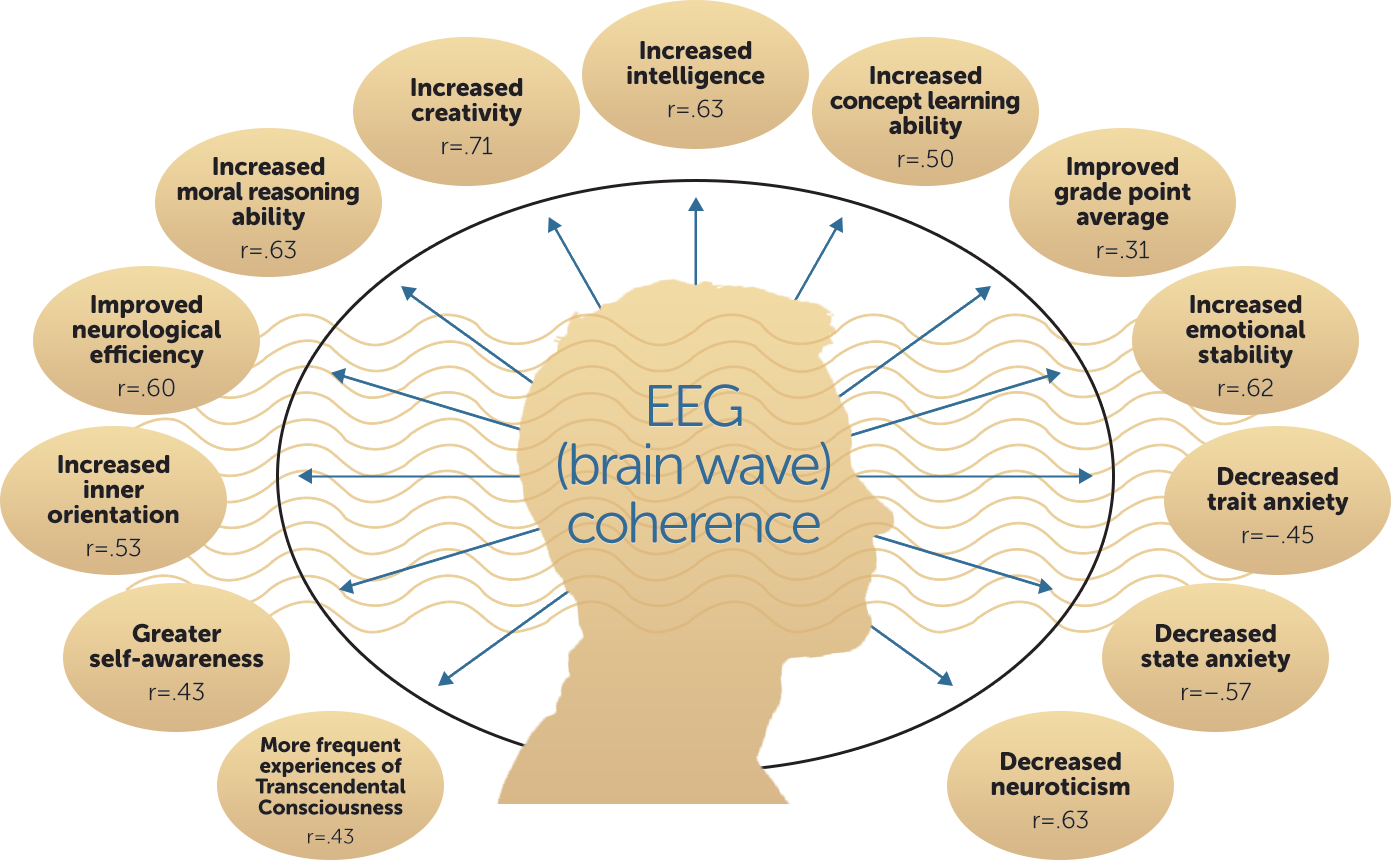
Transcending has an impact not only on our health, well-being, self-esteem, and relationships, but it also has an impact on brain growth, even in people whose brains are meant to be completely grown. How may a simple experience alter the brain in ways that were previously difficult to believe, such as enhanced IQ and creativity in adults, and so on?
However, the impacts are plainly detectable, for example, by EEG coherence.
When a portion of our brain is active, the electrical activity can be monitored with an electroencephalogram (EEG) and shown as a waveform. Nowadays, two of these waveforms from separate sections of the brain may be sent to a computer and the degree to which these waves are identical, or coherent, can be calculated analytically. A high coherence indicates that these many areas of the brain work together as one unit.
Transcending is fundamentally a sense of togetherness. This can be measured directly in the brain. Here's a video that shows how EEG coherence peaks during the TM practice in real-time.
Frequently Asked Questions
Is everyone capable of learning?
Yes, TM is so basic, natural, and easy to learn that children as young as six can do it! And you can never be too old! Anyone who can think is capable of meditating!
My mind is constantly racing; I could never meditate!
Many people say this before beginning to meditate, however, the true objective of meditation is not to calm the mind or the body (although this will happen spontaneously as a result of the practice). There is no attempt to concentrate or control the mind since, just as the mind is wired to be active, it is also wired to be still when given the opportunity. Any organism in nature that can be active must also be able to be less active, and eventually completely still. The mind is included in this. You'll have no trouble after you've figured out how to meditate properly.
What is the distinction between TM and mindfulness?
The purpose of TM, unlike mindfulness, is not to focus on your breath, a word or phrase, or your surroundings. It is instead to move beyond thoughts and feelings while remaining conscious in order to attain deep mind-body relaxation. Mantras in transcendental meditation are not as inspiring, aspirational, or grounded as mantras in other meditation methods. Rather, they offer a nondistracting, non-focused method of calming the mind.
How much time does it take each day? I doubt I'd have the time!
Only 20 minutes of TM twice a day is recommended to provide you with the benefits of hours of most other approaches. Even if you don't have 40 minutes a day, you will reap significant benefits. And because it's so pleasurable and simple to do, you'll find it far simpler to stick with it than anything else you've tried. It also helps that you can practice wherever and whenever you want! Very busy people frequently remark after a short period of TM practice that they have sacrificed 40 minutes a day and appear to have gained a couple of hours, since when we come out of meditation, we tend to be more alert and creative, and we get more done in less time.
Is it possible to learn TM online?
TM may be taught electronically, but it would no longer be TM since it would lose a big element of its potential to transform lives. TM is the earliest kind of meditation, dating back to 3000 years or more in Vedic times. The Yogis of India at the time were having spontaneous cognitions in meditation regarding the origins of life, the Universe, and the effortless process of transcending (mind settling into quiet) via which these views of truth were obtained.
Will I have to make changes in my life, such as giving up alcohol, smoking, or sex, or sitting on the floor?
No. You are not required to make any sacrifices. It's true that certain meditation organizations encourage you to give up these things because they want you to manage your thoughts. However, with TM, excellent habits emerge spontaneously and naturally as a result of meditation, rather than being a prerequisite for learning! And sex is not an impediment to meditation. As a result of TM, any addiction or preoccupation will tend to disappear, while enjoyment of life will improve. Another benefit of meditation is improved posture. Unless you want not to, you will sit on a chair during your course. And we strongly advise against making any abrupt changes to your seating position.
How long will it take to see results?
As previously stated, some people will notice the benefits right immediately, while others will take longer. But this is merely a perceptual difference; it will work from the first meditation.
Will TM training alter my personality?
TM eliminates our harmful habits of thought, speech, or action by dissolving the stress that distorts our personality, allowing the true, lovely you to shine through! Many people have found that when they are calmer on the inside, they become more self-assertive, self-confident, and aware. There has been no change in my personality; I am simply more balanced.
Do we not require stress in order to function properly?
We believe that this is a poor application of the term "stress." Most of us appreciate a challenge in our life because it motivates us and helps us achieve amazing things. But, at some point (which varies from person to person), that challenge might become stressful and counter-productive. When you're fatigued, worried, or under pressure, you're more prone to make errors. Being clear-headed, calm, and rested promotes creativity. For thousands of years, Indian yogis have described the silence of meditation as a condition of restful awareness,' wide awake but still. When this characteristic is brought to the surface level of the mind during meditation, it replaces the nervous tension that many people had previously relied on for stimulation. Thousands of meditators have found themselves to be more creative, clear-headed, successful, and stress-free as a result of this.
Will it contradict my religious beliefs?
It will not happen. TM has been learned by people of many faiths. Many Transcendental Meditation teachers are Christian, Jewish, Muslim, Hindu, Buddhist, and other faiths. TM has been taught to priests, monks, nuns, and even a few bishops, and the most common comment is that it has deepened their religion. There is a notable distinction, Yoga predates religion by thousands of years.
Is it safe for me to meditate if I have a mental disease, epilepsy, or a brain injury?
Yes, it is secure. TM cannot damage you because it is a natural procedure that provides profound rest to both the mind and the body, progressively reducing symptoms and providing more mental stability (see 'Benefits of TM'). It will not, however, prevent you from experiencing many of the other benefits mentioned in the study. We may make certain adaptations to the teaching to account for mental illness, so please make this known to your instructor on the teacher's information form before instruction. Every TM student receives as much help and coaching as they require based on their specific needs.
How much does it cost to learn TM?
According to Nader, the cost of TM varies depending on your age, student status, and income.
Most local centers provide a free introductory session so you may learn more about TM.
The courses themselves can range between $300 and $1,000, depending on where you take them. Learning TM consists of four days of training and follow-ups with an instructor, either in person or via an app. The student can get follow-up help at TM centers for the rest of their lives.
Are there side effects?
TM often has no significant side effects. Quiet silence, on the other hand, can occasionally aggravate some disorders, such as anxiety, schizophrenia, or PTSD. Before beginning, it is critical to consult with a healthcare provider and a meditation teacher about any mental health difficulties.
How long does it take for TM to work?
Nader claims that after four days of instruction and individual practice, people may finish TM training and see benefits. Instruction comprises an initial session with a teacher, three follow-up sessions, and at-home practice.
When and how long should you practice TM?
Adults should practice TM for 20 minutes twice daily, preferably before breakfast and dinner. Children under the age of ten often practice TM for 5 minutes with their eyes open, progressively increasing to longer times as they grow older.
Conclusion
Oprah and Lady Gaga are among the celebrities that practice transcendental meditation. However, the foundations have been in place for generations.
A person needs to engage with a licensed teacher to learn how to perform transcendental meditation. Lower blood pressure and fewer stress may be among the advantages.
Before you begin, always consult with a healthcare practitioner, especially if you have a history of psychiatric disorder.


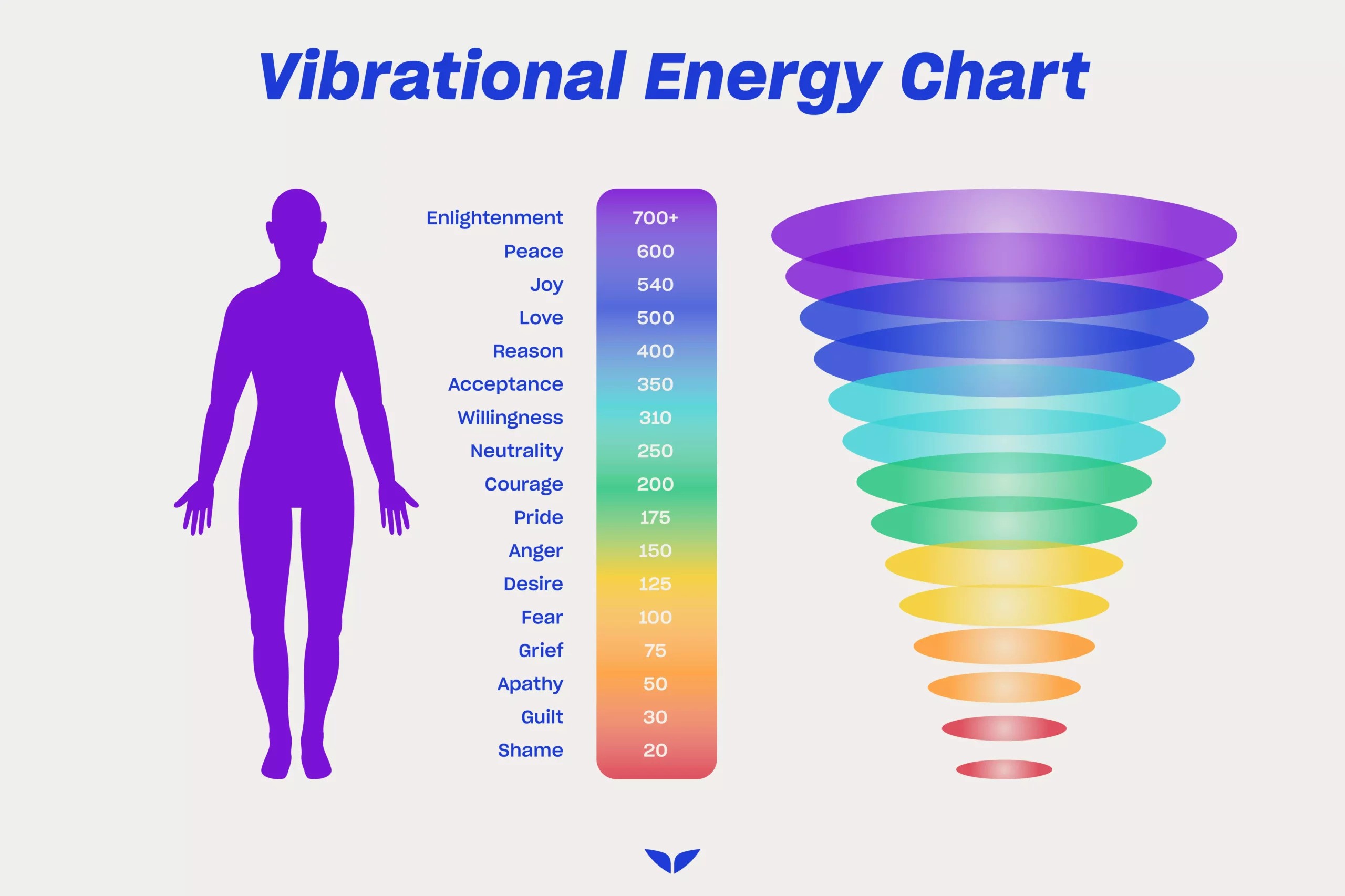
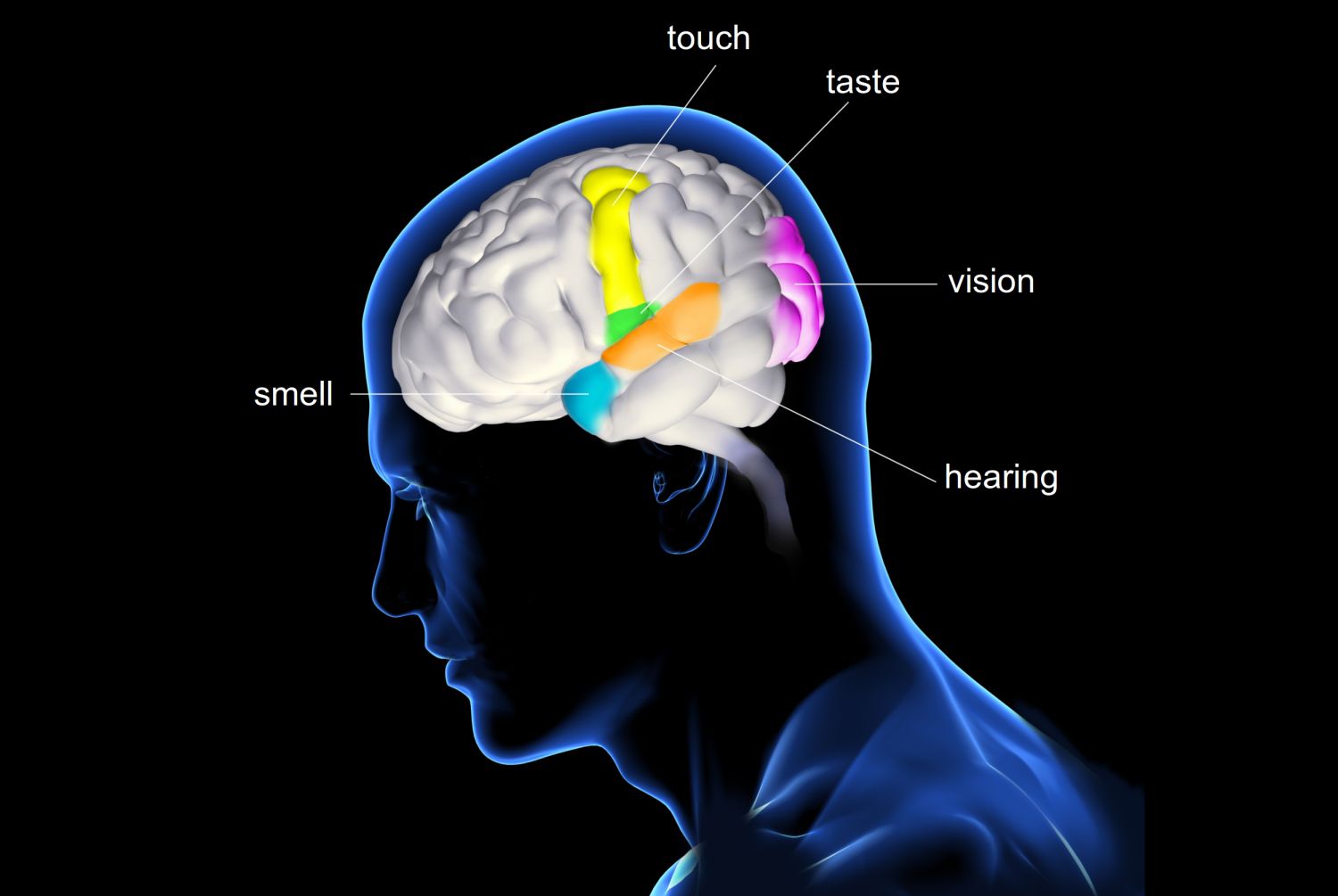
Your style is really unique in comparison to other people I have read stuff from.
Thank you for posting when you’ve got the opportunity,
Guess I will just bookmark this page.